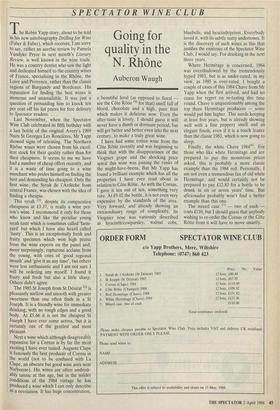SPE CTATOR WINE CLUB
Going for quality in the N. Rhone
Auberon Waugh
Last November, when the Spectator Wine Club celebrated its fifth birthday with a last bottle of the original Avery's 1969 Nuits St Georges Les Roncieres, Mr Yapp showed signs of relenting. The Northern Rh6ne wines were chosen from his excel- lent stock for their quality rather than for their cheapness. It seems to me we have had a number of cheap offers recently, and it is a waste of time going to a wine merchant who prides himself on finding the best and demanding his cheapest. Only the first wine, the Syrah de l'Ardeche from central France, was chosen with the idea of finding a cheapie. This syrah (1), despite its comparative cheapness at £3.37, is really a wine per- son's wine. I recommend it only for those who know and like the peculiar young syrah taste which is sometimes called 'farm- yard' but which I have also heard called `nasty'. This is an exceptionally fresh and fruity specimen which won high praise from the wine experts on the panel and, more surprisingly, rapturous acclaim from the young, with cries of 'good regional mouth' and 'give it us any time', but others were less enthusiastic and I am not sure I will be ordering any myself. I found it fruity and fresh but also a little sharp. Others didn't agree. The 1985 St Joseph from St Desirat (2) is pleasantly mellow and smooth with greater sweetness than one often finds in a St Joseph. It is a friendly wine for immediate drinking, with no rough edges and a good body. At £5.66 it is not the cheapest St Joseph I have ever come across, but it is certainly one of the gentlest and most pleasant.
Next a wine which although disagreeably expensive for a Comas is by far the most exciting I have ever tasted. Auguste Clape is famously the best producer of Comas in the world (not to be confused with La Clape, an obscure but good wine area near Narbonne). His wines are often undrink- ably tannic at this age, but in the milder conditions of the 1984 vintage he has produced a wine which I can only describe as a revelation. It has huge concentration, a beautiful feral (as opposed to floral see the Cote Rotie (4) for that) smell full of blood, chocolate and a high, pure fruit which makes it delicious now. Even the after-taste is lovely. I should guess it will never have a dumb or dormant period, but will get better and better even into the next century, to make a truly great wine.
I have had some rotten wine from the Cote Rotie recently and was beginning to think that with the disappearance of the Viognier grape and the shocking price spiral this wine was joining the ranks of the might-have-beens. But Mr Yapp has found a brilliant example which has all the properties I have ever read about in relation to Cite Rotie. As with the Comas, I gave it ten out of ten, something very rare. At £9.02 the bottle, it is not even very expensive by the standards of the area. Very forward, and already showing an extraordinary range of complexity, its Viognier nose was variously described as hyacinth/cowparsley, walnut cobs, bluebells, and hyacinth/privet. Everybody loved it, with its subtle nutty undertones. It is the discovery of such wines as this that justifies the existence of the Spectator Wine Club, I would say. For drinking in the next three years.
Where Hermitage is concerned, 1984 was overshadowed by the tremendously hyped 1983, but is as under-rated, in my view, as 1985 is over-rated. I bought a couple of cases of this 1984 Chave from Mr Yapp when the first arrived, and had no cause for regret on re-tasting this time round. Chave is unquestionably among the top three Hermitage producers — some would put him higher. This needs keeping at least five years, but is already showing well with a fine peppery smell and an elegant finish, even if it is a touch leaner than the classic 1983, which is now going to sleep. Finally, the white Chave 1984(6). For those who like white Hermitage and are prepared to pay the monstrous prices asked, this is probably a more classic example than the 1984 red. Personally, I am not even a tremendous fan of old white Hermitage, and would certainly not be prepared to pay £12.83 for a bottle to be drunk in six or seven years' time. But aficionados probably won't find a better example than this one. The mixed case (7) — two of each costs £110, but I should guess that anybody wishing to re-order the Comas or the Cote Rotie from it will have to move smartly.


















































 Previous page
Previous page